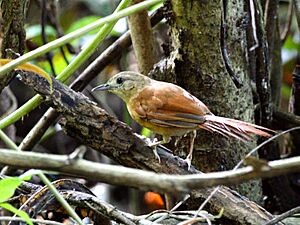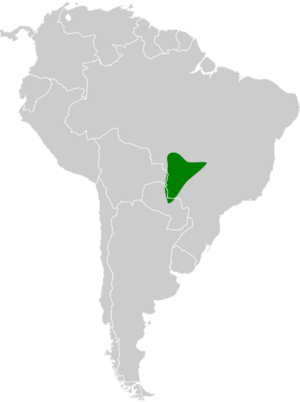White-lored spinetail facts for kids
Quick facts for kids White-lored spinetail |
|
|---|---|
 |
|
| Conservation status | |
| Scientific classification | |
| Genus: |
Synallaxis
|
| Species: |
albilora
|
 |
|
The white-lored spinetail (scientific name: Synallaxis albilora) is a small bird. It belongs to the ovenbird family, called Furnariidae. You can find this bird in parts of Bolivia, Brazil, and Paraguay.
Contents
About Its Name and Family
The white-lored spinetail is a unique species. This means it doesn't have different subspecies. Its scientific name is Synallaxis albilora. Scientists sometimes change how they group birds. For example, another bird, the Araguaia spinetail, used to be considered the same as the white-lored spinetail.
What Does the White-Lored Spinetail Look Like?
This bird is about 15 to 16 centimeters (6 inches) long. It weighs between 13 and 17 grams (about half an ounce). Both male and female birds look the same.
They have dull whitish patches near their eyes, called "lores." The rest of their face is brownish-gray. Their head and upper back are grayish-brown. Their lower back and rump are a bright reddish-brown. The feathers covering their tail are dark reddish-brown.
Their wings are bright reddish-brown. The tips of their flight feathers are dark brownish. Their tail is dark reddish-brown and gets shorter towards the end. The feathers have blunt tips.
The throat of the white-lored spinetail is white. Their belly is mostly a bright orange-yellow color. The middle of their belly is a lighter white color. Their eyes are cinnamon brown. Their upper beak is black or dark gray, and their lower beak is gray. Their legs and feet are gray or dull brownish.
Where Does This Bird Live?
The white-lored spinetail lives in southern Mato Grosso and western Mato Grosso do Sul in Brazil. It also lives in southeastern Bolivia and northern Paraguay.
It likes to live in the thick plants under the trees in gallery forests. These are forests that grow along rivers. It also lives in woodlands near rivers and in scrublands. You can find this bird in areas below 1,000 meters (3,300 feet) in height.
How Does the White-Lored Spinetail Behave?
Staying in One Place
The white-lored spinetail stays in the same area all year long. It does not migrate to other places.
What Does It Eat?
This bird eats arthropods, which are creatures like insects and spiders. It usually looks for food alone or with one other bird. They search in vines and thick plants close to the ground. They usually stay about 2 meters (7 feet) above the ground. They pick their food from the ground, leaves, and small branches.
Life Cycle and Reproduction
The main time for white-lored spinetails to have babies is from August to December. However, they can start as early as June and continue until February. Pairs have been seen trying to breed three times in one season.
Their nest is a big pile of sticks. It has a tunnel that leads to a hidden room inside. This room is lined with soft things like leaves. Both the male and female birds help build the nest. They usually place it in a bush or a small tree, up to about 7 meters (23 feet) above the ground.
A female bird usually lays three or four eggs. The eggs hatch after about 15 days. The baby birds leave the nest about 13 to 14 days after they hatch. Both parent birds help take care of the nestlings.
How Does It Communicate?
The white-lored spinetail's song sounds like repeated, sharp "keeew kiw-kweet" notes. It also makes a single, nasal sound that is often repeated many times. Both male and female birds sing. They mostly sing in the morning. They usually sing from a hidden spot in the plants.
Is the White-Lored Spinetail Safe?
The IUCN (International Union for Conservation of Nature) says the white-lored spinetail is a species of "least concern." This means it is not in danger of disappearing. It lives in a fairly large area. Scientists don't know the exact number of these birds, but they believe the population is stable.
No immediate threats have been found for this bird. It is considered common, especially in the Pantanal region, where many can be found in good habitats. It also lives in several protected areas.


